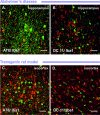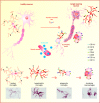Who fans the flames of Alzheimer's disease brains? Misfolded tau on the crossroad of neurodegenerative and inflammatory pathways
- PMID: 22397366
- PMCID: PMC3334709
- DOI: 10.1186/1742-2094-9-47
Who fans the flames of Alzheimer's disease brains? Misfolded tau on the crossroad of neurodegenerative and inflammatory pathways
Abstract
Neurodegeneration, induced by misfolded tau protein, and neuroinflammation, driven by glial cells, represent the salient features of Alzheimer's disease (AD) and related human tauopathies. While tau neurodegeneration significantly correlates with disease progression, brain inflammation seems to be an important factor in regulating the resistance or susceptibility to AD neurodegeneration. Previously, it has been shown that there is a reciprocal relationship between the local inflammatory response and neurofibrillary lesions. Numerous independent studies have reported that inflammatory responses may contribute to the development of tau pathology and thus accelerate the course of disease. It has been shown that various cytokines can significantly affect the functional and structural properties of intracellular tau. Notwithstanding, anti-inflammatory approaches have not unequivocally demonstrated that inhibition of the brain immune response can lead to reduction of neurofibrillary lesions. On the other hand, our recent data show that misfolded tau could represent a trigger for microglial activation, suggesting the dual role of misfolded tau in the Alzheimer's disease inflammatory cascade. On the basis of current knowledge, we can conclude that misfolded tau is located at the crossroad of the neurodegenerative and neuroinflammatory pathways. Thus disease-modified tau represents an important target for potential therapeutic strategies for patients with Alzheimer's disease.
Figures




References
-
- Grundke-Iqbal I, Iqbal K, Quinlan M, Tung YC, Zaidi MS, Wisniewski HM. Microtubule-associated protein tau: a component of Alzheimer paired helical filaments. J Biol Chem. 1986;261:6084–6089. - PubMed
-
- Wischik CM, Novak M, Thøgersen HC, Edwards PC, Runswick MJ, Jakes R, Walker JE, Milstein C, Roth M, Klug A. Isolation of a fragment of tau derived from the core of the paired helical filament of Alzheimer disease. Proc Natl Acad Sci USA. 1988;85:4506–4510. doi: 10.1073/pnas.85.12.4506. - DOI - PMC - PubMed
Publication types
MeSH terms
Substances
LinkOut - more resources
Full Text Sources
Medical

